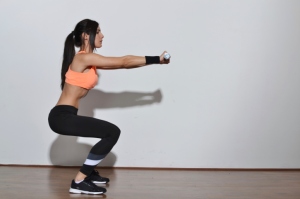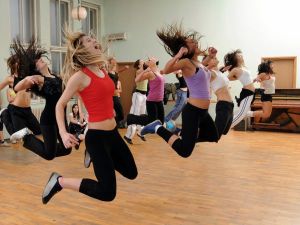Two men cycling in front of the Palace of justice in Putrajaya
Malaysia has the highest percentage of overweight people in South-East Asia and the bulk of them are in Putrajaya. A survey has found that two out of five Malaysian civil servants are obese. The news is not good for the country’s health.
KUALA LUMPUR: It has been long known that Malaysia is the fattest country in South-East Asia. Now, it has been proven that the administrative capital of Putrajaya has the highest rate of overweight and obese people in the country.
Findings from the 2015 National Health and Morbidity Survey (NHMS) placed Putrajaya as the city with the highest percentage of overweight, obese and abdominally obese people in the country.
The study also suggests that the administrative capital’s population has a 37% chance of being overweight, while the obesity rate stood at 43%.
Even more startling, the NHMS said government and semi-government employees took the cake as those struggling most with obesity, with a 40.3% rate.
This could mean two out of every five of Malaysia’s civil servants may be obese.
Malaysia’s civil service has 1.4 million employees, according to the Prime Minister’s Office, and is the largest civil service in South-East Asia.
Other obesity demographics pointed out in the survey were Indians (43.5%), married adults (33.8%) and those who only studied up to secondary school (32.1%).
The findings put the Government in a rather red-faced situation, as it works on reversing the climbing number of obese and overweight Malaysians.
“As the number of people with obesity increases, the nation now is facing an upward surge of non-communicable diseases such as diabetes and cardiovascular diseases,” the survey concluded, describing the Malaysian obesity epidemic as alarming.
Although a review of public health policy was not necessary now, it opined, the Government was asked to provide more supportive environments for Malaysians to lead healthier lifestyles.
Malaysian Medical Association (MMA) president Dr Ashok Zachariah Phillip agreed, saying that the life of a typical government servant did not afford them much time or money to stay healthy.
“If you look at the strata, it’s usually the lower grade workers who are overweight because it takes money to keep fit. Government workers go to work at 7am, come back at 7pm and have no time between work and family to even think of exercising,” he said.
It doesn’t help either that basic essentials like white rice, sugar and oil are staple Malaysian diets and are unhealthy, he said.
“For us doctors, this could be a real headache 20 years down the road. We are going to have a growing population with stroke and heart disease, and kidney failures that will increase the health budget at an unsustainable level,” he added.
The Government needs to look into setting up more gyms in agencies and dish out incentives for employees to fight the bulge.
Health Minister Datuk Seri Dr S. Subramaniam said the figures were worrying.
“I don’t think the people are in the best state of health,” he said.
He said general sedentary work has a correlation to obesity, a trend which government agencies, namely the police, were trying to counter.
“The police recognised this recently and have taken some effort to make sure they have lean policemen. They will try to take action to meet this target,” Dr Subramaniam said yesterday.
Malacca and Perlis are the states with second and third highest obesity rates. Sabah and the Federal Territory of Labuan were the slimmest states.
By Micholas Cheng The Star
Address obesity urgently
AMID the current heat wave, not only are we blue over the greens (The Star, April 4) with highland vegetables wilting and Ipoh’s famous pomelos shrinking in size, schoolchildren are also getting more obese with the sound advice from the authorities to stay indoors.
Presumably, many children will go in droves to air-conditioned malls and fast food restaurants for meals, which naturally will add to the problem of obesity.
Doctors say obesity is defined as the condition of being very overweight and having a body mass index, or BMI, of 30 or higher. The BMI is a measure of the weight relative to the height.
Evidently, obesity is manifested in the abdominal fat around the waist of children and adults as well.
But we should not get unduly worried with the adults because they are mature and knowledgeable enough to take responsibility for their health.
However, the innocent children’s health is undeniably our responsibility. Like it or not, we are accountable and answerable for the obesity problem in their adult life.
Today we can see the startling increase in the number of obese children across the country. Yet many parents unfortunately are seemingly too busy to check their children’s diet, let alone their daily exercise like the recommended walk of up to 10,000 steps a day.
Perhaps schools should voluntarily take up the task of creating awareness about the high risks and health hazards of obesity.
One practical way is to do routine short workouts: get students to burn calories by doing some exercises in the school assembly or in class every day – even some stretching exercises will suffice.
Certainly, this will increase their metabolic rate, thus strengthening their mental ability to learn; reducing levels of stress and depression; and suppressing the appetite.
When the heat wave is over, I would say it is the ethical and moral responsibility of the school authorities to bring back the Physical Standard Tests for all students like the good old days and mobilise all the staff to run selected athletic events such as the 100m, 200m, long jump, high jump and shot putt. Set certain standards for the events.
It would be much better if the Education Ministry’s Sports Department sets the national standards for all these events, which was done in the 60s till the 80s by using the co-curriculum 001 and 002 cards.
Next, it is also incumbent upon the Education Ministry to make it mandatory for school canteens to display the calorie counts for all the food so that the children will learn how to make healthy food choices and to calculate the total calorie intake they require for a day (about 1,600 and 2,500 calories per day depending on their age, gender and activity level).Eventually, they will “graduate” to become smart healthy consumers.
Let’s take these critical measures seriously to save our children from potential health risks like diabetes, high blood pressure, high cholesterol, heart disease and also some cancers.
This will invariably reduce the national health bill as well.
It was reported in “Putrajaya tops obese list” (see above) that we already have the highest percentage of overweight people in South-East Asia, and two out of five civil servants are obese.
Hence, invariably, the Government has to increase the health budget to cater for our increasingly ailing population if the obesity problem is not urgently addressed.
THOMAS KOK Ipoh
Related story: Healthy when young, healthy when old

 Related posts:
Related posts:The Corruption case in the Youth & Sports Ministry...
Scientists Finally Discover How the Obesity Gene Works
Jun 15, 2015 ... If it is an entire protein supplement you are consuming such as whey powder,
then consuming the product within 30 minutes post workout ...













